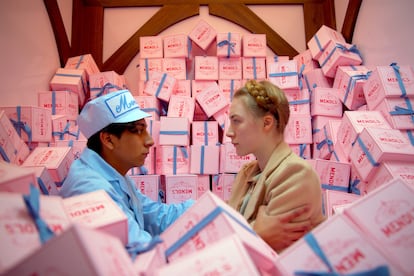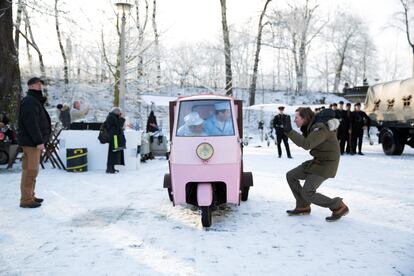Turning life into a Wes Anderson movie: What’s behind the viral trend?
TikTok users are adopting the director’s famous cinematic style to put a romantic twist on the everyday. These quaint videos have already racked up a billion views

“Routine seen through Wes Anderson’s eyes is always prettier,” one friend commented to another in a coffee shop this week as she showed the latest reel she had uploaded to Instagram. And maybe she’s right; the viral TikTok trend under the hashtag #WesAnderson has already racked up a billion views. Capturing idyllic vacations in Spain in vibrant colors, sharing images of everyday moments and objects and even making use of artificial intelligence have become a way of looking at day-to-day life that captivates millions of users around the world.
Clearly, Anderson’s unique point of view behind the camera has earned the director the well-deserved title of king of the beautiful and colorful. His aesthetic, inspired by 1960s and 1970s popular culture and design, appeals to people because it provides an escape from how we see the everyday. It fills it with detail and color, creating an imaginary world that always seems better than the real one. His attention to detail and composition make the ordinary seem extraordinary. That is one reason for his popularity on social media.
@danclemt Vacations but #wesanderson #wesandersontrend #colors #accidentallywesanderson #foryou #pourtoi #foryoupage #summer
♬ Obituary - Alexandre Desplat
Victor López G., a film critic and content creator, believes there are three important factors that sum up the success of Wes Anderson’s cinematic view of reality. “Symmetry is tremendously attractive to the brain, since it is easy to analyze and process; it creates a sense of order, elegance and simplicity,” he says. This — along with zenithal shots, the ones that are seen from above — creates a pleasant sensation for the viewer while the characters interact and seem to be part of the story in an integrated way.
The second factor is Anderson’s treatment of color, one of the clearest hallmarks of his movies. “As the years go by, the industry has been embracing grayer palettes, and Anderson is a big supporter of color on the big screen,” comments Lopez. “That goes far beyond the purely aesthetic, because the color palette is integrated into the narrative and helps to tell the story.”
Finally, light is a character with its own identity: it creates a depth of field and makes it possible to appreciate the landscape and scenery in each shot. “Although it may seem simple, Wes’ filmmaking is very complex,” the film critic says. “Frontality, symmetry, color and light are easy to imitate, which has really helped make this trend go viral quickly.”

All of the above, combined with the right conditions, creates a perfect cocktail for TikTok: short videos that hold users’ attention with catchy music and scenes that can easily be replicated at home. But is this part of a general trend to idealize reality on social media and escape the monotony and boredom of real life? What is behind this obsession with making everything beautiful? Why do we tend to romanticize the routine?
@elpais Cómo hacer un #periodico ( al estilo #wesanderson ) #wesandersonedit #wesandersonfilm #wesandersonaesthetic #wesandersoninspired #wesandersonmovie #BookTok #wesandersontrend #accidentallywesanderson
♬ original sound - TJ Grewal
Digital strategist Raquel Carrera says that the trend reflects our living, social and economic situations: “We are living in a time of chaos, and that makes us terribly fragile. Historically, vulnerability leads us to seek out beauty, to turn our existence into something beautiful, because it is one of the few things over which we feel we have some control.”
Social networks are an avatar of real life; each user chooses what to show, even if it is not necessarily 100% true, and exhibits his or her own authenticity to followers. The aesthetics of Wes Anderson’s films are perfect for doing that, as his imaginary world with beautiful wardrobes translate to an ideal that we can share and aspire to. “It’s content that you can consume in a loop and imitate; it’s the perfect formula,” says Carrera.
@irinahp Accidentally Wes Anderson in Budapest. For those who're planning on visiting it soon, here some of my favorite spots in the city: • Gellért Baths (retro vibes) • New York Café: most beautiful café • The Parliament (especially magical at night) • hotels: Anantara Hotel, Baltazar, Brody House #accidentallywesanderson #wesandersontrend #wesanderson #budapest
♬ Obituary - Alexandre Desplat
A phenomenon beyond TikTok
But Wes Anderson’s success goes beyond his filmography and this social media trend. He has become an icon of today’s popular culture, and his harmonious world has crossed all boundaries. From his color palettes to the graphic design of his films, the director has a legion of fans eager to discover and share his unique way of seeing the world. Wes Anderson knows how to tell stories and take them beyond the cinematic spectrum of preciousness and bliss.
The Instagram account Accidentally Wes Anderson (AWA) is a perfect example of this phenomenon. With almost two million followers, AWA has managed to take advantage of Anderson’s style by transferring it from the big screen to ordinary spaces, creating travel guides and looking for atypical places that could easily come from one of the director’s films. AWA is a personal project that seeks to inspire thousands of followers with their eagerness for adventure and curiosity. On their website, the creative couple behind AWA perfectly summarizes the secret to their success: “AWA has built upon Wes’ imaginative scenes and seeks out their real-life counterparts around the globe. We are forever indebted to Wes for opening our eyes to the beauty that surrounds us.”
Indeed, Anderson has also brought his vision to the real world. In 2015, Milan’s Prada Foundation commissioned the director to design its coffee shop. He recreated a traditional Milanese bar, bringing to life its colors and shapes. However, his approach differed from the one he uses on his film sets. He thought about it from the perspective of a daily meeting place, where workers drink and enjoy coffee — not from the ideal world in which imaginary stories happen. “It is for real life, and ought to have numerous good spots for eating, drinking, talking, reading, etc. While I do think it would make a pretty good movie set, I think it would be an even better place to write a movie. I tried to make it a bar I would want to spend my own non-fictional afternoons in,” Anderson said of Bar Luce. Thus, he conceived the café as a place where the everyday exists within the domain of the romantic. Its 1960s aesthetic makes it a perfectly Instagrammable scene, in which the imaginary is within anyone’s reach.
Sign up for our weekly newsletter to get more English-language news coverage from EL PAÍS USA Edition
Tu suscripción se está usando en otro dispositivo
¿Quieres añadir otro usuario a tu suscripción?
Si continúas leyendo en este dispositivo, no se podrá leer en el otro.
FlechaTu suscripción se está usando en otro dispositivo y solo puedes acceder a EL PAÍS desde un dispositivo a la vez.
Si quieres compartir tu cuenta, cambia tu suscripción a la modalidad Premium, así podrás añadir otro usuario. Cada uno accederá con su propia cuenta de email, lo que os permitirá personalizar vuestra experiencia en EL PAÍS.
¿Tienes una suscripción de empresa? Accede aquí para contratar más cuentas.
En el caso de no saber quién está usando tu cuenta, te recomendamos cambiar tu contraseña aquí.
Si decides continuar compartiendo tu cuenta, este mensaje se mostrará en tu dispositivo y en el de la otra persona que está usando tu cuenta de forma indefinida, afectando a tu experiencia de lectura. Puedes consultar aquí los términos y condiciones de la suscripción digital.
More information
Archived In
Últimas noticias
Maduro pleads not guilty before the federal court in New York: ‘I am still the president of Venezuela’
A new test can detect Alzheimer’s from a finger prick
UN team enters Sudanese city of El Fasher after paramilitary massacre: ‘It’s like a ghost town’
A recipe for resistance: Indigenous peoples politicize their struggles from the kitchen
Most viewed
- Gilles Lipovetsky: ‘If you want to live better and fall in love, take Prozac, don’t look to philosophy’
- Alain Aspect, Nobel laureate in physics: ‘Einstein was so smart that he would have had to recognize quantum entanglement’
- Alvin Hellerstein, a 92-year-old judge appointed by Bill Clinton, to preside over Maduro’s trial in New York
- Why oil has been at the center of Venezuela-US conflicts for decades
- Maduro’s downfall puts China’s relationship with Venezuela to the test









































